Exploring Immersive Co-Design: Comparing Human Interaction in Real and Virtual Elevated Urban Spaces in London
Abstract
1. Introduction
1.1. Research Background
1.2. Elevated Urban Spaces
1.3. Purpose
2. Case Studies
3. Methods
3.1. Walk-Along Interviews
Demographic Data Analysis
3.2. VR Exploratory Experiment and Semi-Structured Interviews
3.2.1. VR Experimental Setup
3.2.2. Participants
3.2.3. Procedures
3.2.4. Demographic Data Analysis
3.3. Qualitative Data Analysis
4. Results
4.1. Circulation
4.2. Design Considerations
4.3. Activities and Participant Interaction
“From my point of view in terms of mental health, especially during the lockdown, it (VR experience) could make a big change, especially for people living alone. It will definitely be suggested, I think it’s an enjoyable element that can bring more happiness and change people’s mood if they use space to socialise with others.”
4.4. Suggested Design Features and Interactive Design
4.4.1. Real Environment Insights: Design Features
4.4.2. Virtual-Reality-Enabled Interactive Design Exploration
5. Discussion
6. Conclusions
Author Contributions
Funding
Institutional Review Board Statement
Informed Consent Statement
Data Availability Statement
Conflicts of Interest
References
- Brain, D. Reconstituting the urban commons: Public space, social capital and the project of urbanism. Urban Plan. 2019, 4, 169–182. [Google Scholar] [CrossRef]
- Fischler, R. Fifty theses on urban planning and urban planners. J. Plan. Educ. Res. 2012, 32, 107–114. [Google Scholar] [CrossRef]
- Carmona, M.; Tiesdell, S.; Heath, T.; Oc, T. Public Places, Urban Spaces: The Dimensions of Urban Design; Routledge: London, UK, 2010. [Google Scholar]
- Rall, E.; Hansen, R.; Pauleit, S. The added value of public participation GIS (PPGIS) for urban green infrastructure planning. Urban For. Urban Green. 2019, 40, 264–274. [Google Scholar] [CrossRef]
- Stanfield, E.; van Riemsdijk, M. Creating public space, creating ‘the public’: Immigration politics and representation in two Copenhagen parks. Urban Geogr. 2019, 40, 1356–1374. [Google Scholar] [CrossRef]
- Ismail, W.A.W.; Said, I. Integrating the community in urban design and planning of public spaces: A review in Malaysian cities. Procedia-Soc. Behav. Sci. 2015, 168, 357–364. [Google Scholar] [CrossRef]
- Sanoff, H. Community Participation Methods in Design and Planning; John Wiley & Sons: Hoboken, NJ, USA, 2000. [Google Scholar]
- Ho, D.C.; Lai, L.W.; Wang, A. The effects of ‘publicness’ and quality of publicly accessible open space upon user satisfaction. Environ. Plan. B Urban Anal. City Sci. 2021, 48, 861–879. [Google Scholar] [CrossRef]
- Arnstein, S.R. A ladder of citizen participation. J. Am. Inst. Plan. 1969, 35, 216–224. [Google Scholar] [CrossRef]
- Wilson, A.; Tewdwr-Jones, M.; Comber, R. Urban planning, public participation and digital technology: App development as a method of generating citizen involvement in local planning processes. Environ. Plan. B Urban Anal. City Sci. 2019, 46, 286–302. [Google Scholar] [CrossRef]
- Amado, M.P.; Santos, C.V.; Moura, E.B.; Silva, V.G. Public participation in sustainable urban planning. Int. J. Hum. Soc. Sci. 2010, 5, 102–108. [Google Scholar]
- Wates, N. The Community Planning Handbook: How People Can Shape Their Cities, Towns and Villages in Any Part of the World; Routledge: London, UK, 2014. [Google Scholar]
- Nabatchi, T.; Ertinger, E.; Leighninger, M. The future of public participation: Better design, better laws, better systems. Confl. Resolut. Q. 2015, 33, S35–S44. [Google Scholar] [CrossRef]
- Bednarska-Olejniczak, D.; Olejniczak, J.; Svobodová, L. Towards a smart and sustainable city with the involvement of public participation—The case of Wroclaw. Sustainability 2019, 11, 332. [Google Scholar] [CrossRef]
- Sanders, E.B.N.; Brandt, E.; Binder, T. A framework for organizing the tools and techniques of participatory design. In Proceedings of the 11th Biennial Participatory Design Conference, Sydney, Australia, 29 November–3 December 2010; pp. 195–198. [Google Scholar]
- Webb, R.; Bai, X.; Smith, M.S.; Costanza, R.; Griggs, D.; Moglia, M.; Neuman, M.; Newman, P.; Newton, P.; Norman, B.; et al. Sustainable urban systems: Co-design and framing for transformation. Ambio 2018, 47, 57–77. [Google Scholar] [CrossRef]
- Manzini, E.; Rizzo, F. Small projects/large changes: Participatory design as an open participated process. CoDesign 2011, 7, 199–215. [Google Scholar] [CrossRef]
- De Siqueira, G.; Malaj, S.; Hamdani, M. Digitalization, Participation and Interaction: Towards More Inclusive Tools in Urban Design—A Literature Review. Sustainability 2022, 14, 4514. [Google Scholar] [CrossRef]
- Sanders, E.B.-N.; Stappers, P.J. Co-creation and the new landscapes of design. CoDesign 2008, 4, 5–18. [Google Scholar] [CrossRef]
- Stelzle, B.; Jannack, A.; Noennig, J.R. Co-design and co-decision: Decision making on collaborative design platforms. Procedia Comput. Sci. 2017, 112, 2435–2444. [Google Scholar] [CrossRef]
- Bannon, L.J.; Ehn, P. Design: Design matters in Participatory Design. In Routledge International Handbook of Participatory Design; Routledge: London, UK, 2012; pp. 37–63. [Google Scholar]
- De Lange, M.; De Waal, M. Owning the city: New media and citizen engagement in urban design. In Urban Land Use; Apple Academic Press: Point Pleasant, NJ, USA, 2017; pp. 109–130. [Google Scholar]
- Fainstein, S.S. The just city. Int. J. Urban Sci. 2014, 18, 1–18. [Google Scholar] [CrossRef]
- Wolf, M.; Söbke, H.; Wehking, F. Mixed Reality Media-Enabled Public Participation in Urban Planning: A Literature Review. In Augmented Reality and Virtual Reality: Changing Realities in a Dynamic World; Springer: Cham, Switzerland, 2020; pp. 125–138. [Google Scholar]
- Saßmannshausen, S.M.; Radtke, J.; Bohn, N.; Hussein, H.; Randall, D.; Pipek, V. Citizen-centered design in urban planning: How augmented reality can be used in citizen participation processes. In Proceedings of the Designing Interactive Systems Conference 2021, Virtual Event, 28 June–2 July 2021; pp. 250–265. [Google Scholar]
- Jamei, E.; Mortimer, M.; Seyedmahmoudian, M.; Horan, B.; Stojcevski, A. Investigating the role of virtual reality in planning for sustainable smart cities. Sustainability 2017, 9, 2006. [Google Scholar] [CrossRef]
- Yu, R.; Gu, N.; Lee, G.; Khan, A. A Systematic Review of Architectural Design Collaboration in Immersive Virtual Environments. Designs 2022, 6, 93. [Google Scholar] [CrossRef]
- Hasler, S.; Chenal, J.; Soutter, M. Digital tools as a means to foster inclusive, data-informed urban planning. Civ. Eng. Archit. 2017, 5, 230–239. [Google Scholar] [CrossRef]
- Meenar, M.; Kitson, J. Using multi-sensory and multi-dimensional immersive virtual reality in participatory planning. Urban Sci. 2020, 4, 34. [Google Scholar] [CrossRef]
- Van Leeuwen, J.P.; Hermans, K.; Jylhä, A.; Quanjer, A.J.; Nijman, H. Effectiveness of virtual reality in participatory urban planning: A case study. In Proceedings of the 4th Media Architecture Biennale Conference, Beijing, China, 13–16 November 2018; pp. 128–136. [Google Scholar]
- Kim, S.; Kim, J.; Kim, B. Immersive virtual reality-aided conjoint analysis of urban square preference by living environment. Sustainability 2020, 12, 6440. [Google Scholar] [CrossRef]
- Safikhani, S.; Keller, S.; Schweiger, G.; Pirker, J. Immersive virtual reality for extending the potential of building information modeling in architecture, engineering, and construction sector: Systematic review. Int. J. Digit. Earth 2022, 15, 503–526. [Google Scholar] [CrossRef]
- Sanchez-Sepulveda, M.; Fonseca, D.; Franquesa, J.; Redondo, E. Virtual interactive innovations applied for digital urban transformations. Mixed approach. Future Gener. Comput. Syst. 2019, 91, 371–381. [Google Scholar] [CrossRef]
- Schrom-Feiertag, H.; Stubenschrott, M.; Regal, G.; Matyus, T.; Seer, S. An interactive and responsive virtual reality environment for participatory urban planning. In Proceedings of the 11th Annual Symposium on Simulation for Architecture and Urban Design, Online, 25–27 May 2020; pp. 1–7. [Google Scholar]
- Zhang, C.; Zeng, W.; Liu, L. UrbanVR: An immersive analytics system for context-aware urban design. Comput. Graph. 2021, 99, 128–138. [Google Scholar] [CrossRef]
- Mouratidis, K.; Hassan, R. Contemporary versus traditional styles in architecture and public space: A virtual reality study with 360-degree videos. Cities 2020, 97, 102499. [Google Scholar] [CrossRef]
- Portman, M.E.; Natapov, A.; Fisher-Gewirtzman, D. To go where no man has gone before: Virtual reality in architecture, landscape architecture and environmental planning. Comput. Environ. Urban Syst. 2015, 54, 376–384. [Google Scholar] [CrossRef]
- Kim, J.; Kim, S. Finding the optimal D/H ratio for an enclosed urban square: Testing an urban design principle using immersive virtual reality simulation techniques. Int. J. Environ. Res. Public Health 2019, 16, 865. [Google Scholar] [CrossRef] [PubMed]
- Rubio-Tamayo, J.L.; Gertrudix Barrio, M.; García García, F. Immersive environments and virtual reality: Systematic review and advances in communication, interaction and simulation. Multimodal Technol. Interact. 2017, 1, 21. [Google Scholar] [CrossRef]
- Yu, C.P.; Lee, H.Y.; Luo, X.Y. The effect of virtual reality forest and urban environments on physiological and psychological responses. Urban For. Urban Green. 2018, 35, 106–114. [Google Scholar] [CrossRef]
- Panya, D.S.; Kim, T.; Choo, S. An interactive design change methodology using a BIM-based Virtual Reality and Augmented Reality. J. Build. Eng. 2023, 68, 106030. [Google Scholar] [CrossRef]
- Alizadehsalehi, S.; Hadavi, A.; Huang, J.C. From BIM to extended reality in AEC industry. Autom. Constr. 2020, 116, 103254. [Google Scholar] [CrossRef]
- Zaker, R.; Coloma, E. Virtual reality-integrated workflow in BIM-enabled projects collaboration and design review: A case study. Vis. Eng. 2018, 6, 1–15. [Google Scholar] [CrossRef]
- Delgado, J.M.D.; Oyedele, L.; Demian, P.; Beach, T. A research agenda for augmented and virtual reality in architecture, engineering and construction. Adv. Eng. Inform. 2020, 45, 101122. [Google Scholar] [CrossRef]
- Ververidis, D.; Nikolopoulos, S.; Kompatsiaris, I. A Review of Collaborative Virtual Reality Systems for the Architecture, Engineering, and Construction Industry. Architecture 2022, 2, 476–496. [Google Scholar] [CrossRef]
- Astaneh Asl, B.; Dossick, C.S. Immersive VR versus BIM for AEC Team Collaboration in Remote 3D Coordination Processes. Buildings 2022, 12, 1548. [Google Scholar] [CrossRef]
- Du, J.; Zou, Z.; Shi, Y.; Zhao, D. Zero latency: Real-time synchronization of BIM data in virtual reality for collaborative decision-making. Autom. Constr. 2018, 85, 51–64. [Google Scholar] [CrossRef]
- Fox, J.; Bailenson, J.; Binney, J. Virtual experiences, physical behaviors: The effect of presence on imitation of an eating avatar. Presence Teleoperators Virtual Environ. 2009, 18, 294–303. [Google Scholar] [CrossRef]
- Bailey, J.; Bailenson, J.N.; Won, A.S.; Flora, J.; Armel, K.C. Presence and memory: Immersive virtual reality effects on cued recall. In Proceedings of the International Society for Presence Research Annual Conference, Philadelphia, PA, USA, 23 October 2012; pp. 24–26. [Google Scholar]
- Gomez-Tone, H.C.; Alpaca Chávez, M.; Vásquez Samalvides, L.; Martin-Gutierrez, J. Introducing Immersive Virtual Reality in the Initial Phases of the Design Process—Case Study: Freshmen Designing Ephemeral Architecture. Buildings 2022, 12, 518. [Google Scholar] [CrossRef]
- Cho, I.S.; Heng, C.K.; Trivic, Z. Re-Framing Urban Space: Urban Design for Emerging Hybrid and High-Density Conditions; Routledge: London, UK, 2015. [Google Scholar]
- Lehmann, S. Sustainable urbanism: Towards a framework for quality and optimal density? Future Cities Environ. 2016, 2, 1–13. [Google Scholar] [CrossRef]
- Oldfield, P. The Sustainable Tall Building: A Design Primer; Routledge: London, UK, 2019. [Google Scholar]
- Hadi, Y.; Heath, T.; Oldfield, P. Gardens in the sky: Emotional experiences in the communal spaces at height in the Pinnacle@ Duxton, Singapore. Emot. Space Soc. 2018, 28, 104–111. [Google Scholar] [CrossRef]
- Pomeroy, J. The Skycourt and Skygarden: Greening the Urban Habitat; Routledge: London, UK, 2013. [Google Scholar]
- Samant, S. Cities in the Sky: Elevating Singapore’s Urban Spaces. Int. J. High-Rise Build. 2019, 8, 137–154. [Google Scholar]
- Viñoly, R.; Blomberg, C.; Blanes, M. Challenges and Benefits of Integrating Public Space into Tall Buildings. CTBUH Res. Pap. 2015, 282–287. [Google Scholar]
- Aleta, A.; Meloni, S.; Moreno, Y. A multilayer perspective for the analysis of urban transportation systems. Sci. Rep. 2017, 7, 1–9. [Google Scholar] [CrossRef]
- Madanipour, A. Rethinking public space: Between rhetoric and reality. Urban Des. Int. 2019, 24, 38–46. [Google Scholar] [CrossRef]
- Morato, L.C. Opportunities and Challenges of Municipal Planning in Shaping Vertical Neighbourhoods in Greater London. Urban Plan. 2022, 7, 267–283. [Google Scholar]
- Wood, A.; Safarik, D. Skybridges: A history and a view to the near future. Int. J. High-Rise Build. 2019, 8, 1–18. [Google Scholar]
- Yeang, K.; Powell, R. Designing the ecoskyscraper: Premises for tall building design. Struct. Des. Tall Spec. Build. 2007, 16, 411–427. [Google Scholar] [CrossRef]
- Pomeroy, J. Room at the top—The roof as an alternative habitable/social space in the Singapore context. J. Urban Des. 2012, 17, 413–424. [Google Scholar] [CrossRef]
- Sky-Garden. Sky Garden Visitor Rules & Regulations. 2015. Available online: https://skygarden.london/terms-conditions/ (accessed on 4 May 2020).
- Bosetti, N.; Brown, R.; Belcher, E.; Washington-Ihieme, M. Public London: The Regulation, Management and Use of Public Spaces; Centre for London: London, UK, 2019. [Google Scholar]
- Kusenbach, M. Street phenomenology: The go-along as ethnographic research tool. Ethnography 2003, 4, 455–485. [Google Scholar] [CrossRef]
- Carpiano, R.M. Come take a walk with me: The “Go-Along” interview as a novel method for studying the implications of place for health and well-being. Health Place 2009, 15, 263–272. [Google Scholar] [CrossRef]
- Garcia, C.M.; Eisenberg, M.E.; Frerich, E.A.; Lechner, K.E.; Lust, K. Conducting go-along interviews to understand context and promote health. Qual. Health Res. 2012, 22, 1395–1403. [Google Scholar] [CrossRef] [PubMed]
- Veitch, J.; Flowers, E.; Ball, K.; Deforche, B.; Timperio, A. Designing parks for older adults: A qualitative study using walk-along interviews. Urban For. Urban Green. 2020, 54, 126768. [Google Scholar] [CrossRef]
- Schreier, M. Varianten qualitativer Inhaltsanalyse: Ein wegweiser im dickicht der Begrifflichkeiten. FQS 2014, 15. [Google Scholar] [CrossRef]
- Elo, S.; Kyngäs, H. The qualitative content analysis process. J. Adv. Nurs. 2008, 62, 107–115. [Google Scholar] [CrossRef] [PubMed]
- Hsieh, H.F.; Shannon, S.E. Three approaches to qualitative content analysis. Qual. Health Res. 2005, 15, 1277–1288. [Google Scholar] [CrossRef]
- Braun, V.; Clarke, V. Using thematic analysis in psychology. Qual. Res. Psychol. 2006, 3, 77–101. [Google Scholar] [CrossRef]
- Keung, C.C.W.; Kim, J.I.; Ong, Q.M. Developing a BIM-based MUVR treadmill system for architectural design review and collaboration. Appl. Sci. 2021, 11, 6881. [Google Scholar] [CrossRef]
- Hooks, K.; Ferguson, W.; Morillo, P.; Cruz-Neira, C. Evaluating the user experience of omnidirectional VR walking simulators. Entertain. Comput. 2020, 34, 100352. [Google Scholar] [CrossRef]
- Saredakis, D.; Szpak, A.; Birckhead, B.; Keage, H.A.; Rizzo, A.; Loetscher, T. Factors associated with virtual reality sickness in head-mounted displays: A systematic review and meta-analysis. Front. Hum. Neurosci. 2020, 14, 96. [Google Scholar] [CrossRef]
- Chang, E.; Kim, H.T.; Yoo, B. Virtual reality sickness: A review of causes and measurements. Int. J. Hum. Comput. Interact. 2020, 36, 1658–1682. [Google Scholar] [CrossRef]
- Ehab, A.; Burnett, G.; Heath, T. Enhancing Public Engagement in Architectural Design: A Comparative Analysis of Advanced Virtual Reality Approaches in Building Information Modeling and Gamification Techniques. Buildings 2023, 13, 1262. [Google Scholar] [CrossRef]
- Jalal, A.; Quaid, M.A.K.; Kim, K. A wrist worn acceleration based human motion analysis and classification for ambient smart home system. J. Electr. Eng. Technol. 2019, 14, 1733–1739. [Google Scholar] [CrossRef]
- Cha, H.S.; Im, C.H. Performance enhancement of facial electromyogram-based facial-expression recognition for social virtual reality applications using linear discriminant analysis adaptation. Virtual Real. 2022, 26, 385–398. [Google Scholar] [CrossRef]
- Hsu, F.S.; Lin, W.Y.; Tsai, T.W. Automatic facial expression recognition for affective computing based on bag of distances. In Proceedings of the 2013 Asia-Pacific Signal and Information Processing Association Annual Summit and Conference, Kaohsiung, Taiwan, 29 October–1 November 2013; pp. 1–4. [Google Scholar]
- Schneider, O.; MacLean, K.; Swindells, C.; Booth, K. Haptic experience design: What hapticians do and where they need help. Int. J. Hum. Comput. Stud. 2017, 107, 5–21. [Google Scholar] [CrossRef]
- Gallace, A. Haptic Interaction in Virtual Reality. In Handbook of Research on Implementing Digital Reality and Interactive Technologies to Achieve Society 5.0; IGI Global: Hershey, PA, USA, 2022. [Google Scholar]
- Koller, D.; Klinker, G.; Rose, E.; Breen, D.; Whitaker, R.; Tuceryan, M. Real-time vision-based camera tracking for augmented reality applications. In Proceedings of the ACM Symposium on Virtual Reality Software and Technology, Lausanne, Switzerland, 15–17 September 1997; pp. 87–94. [Google Scholar]
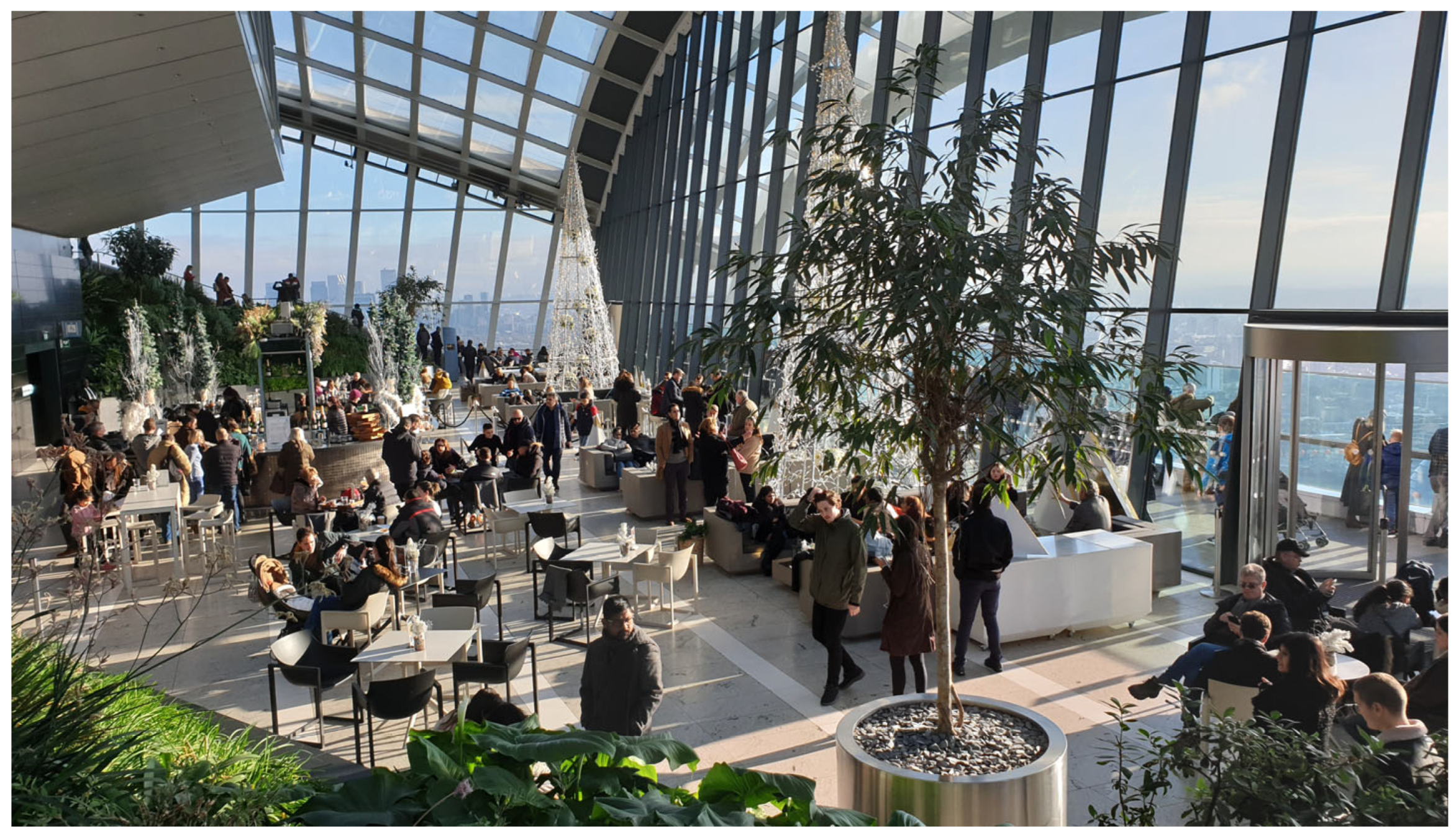
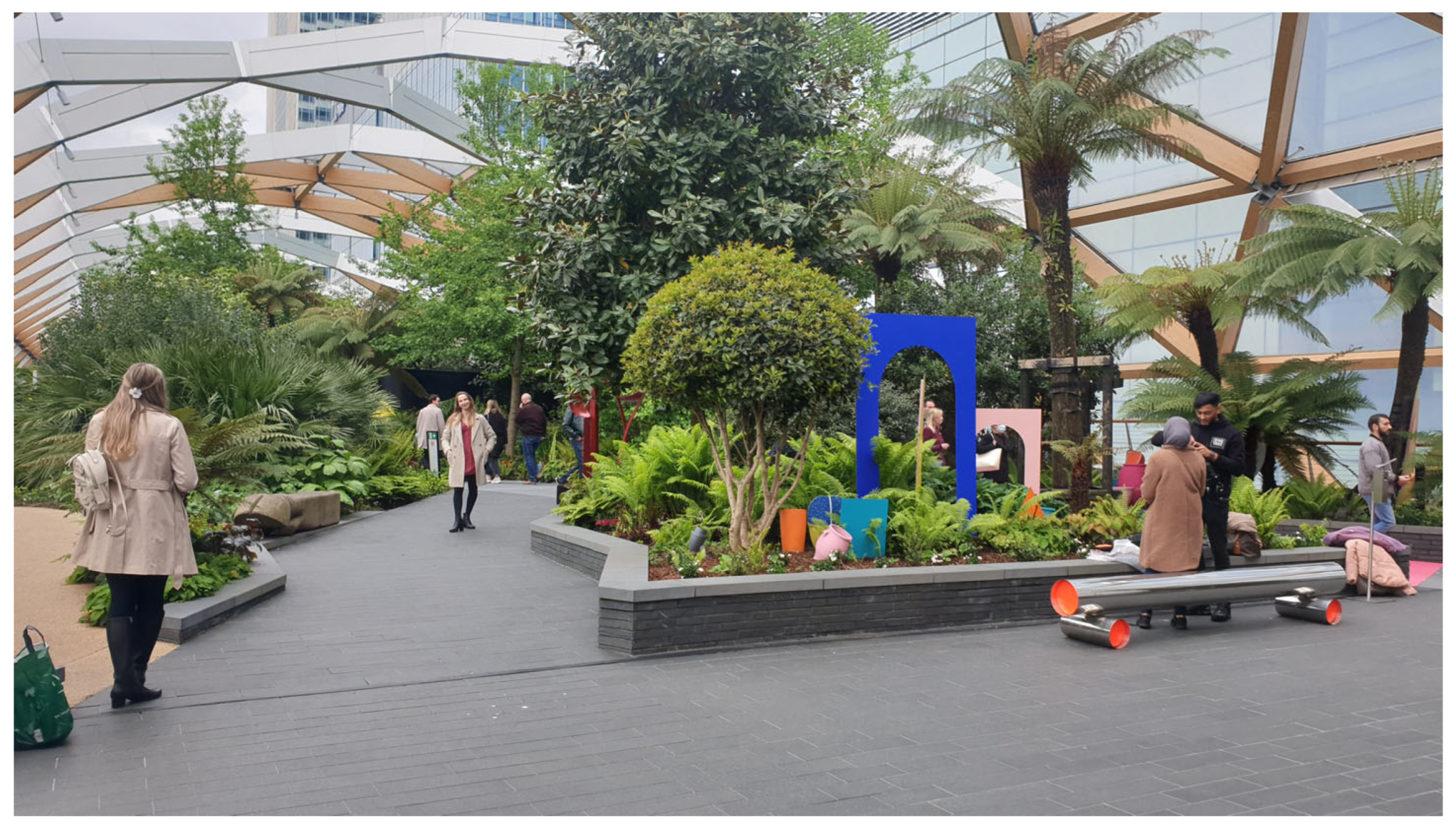




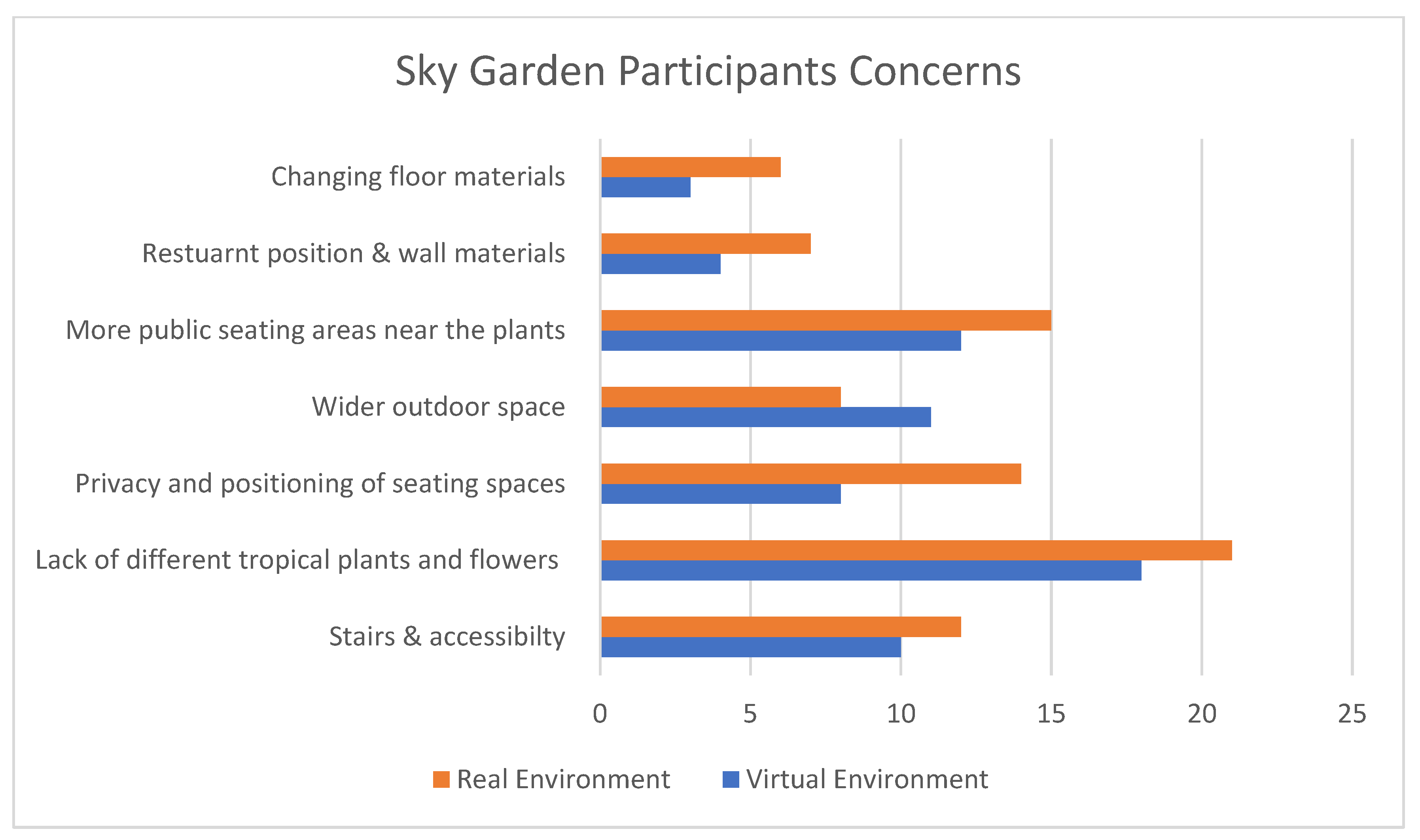
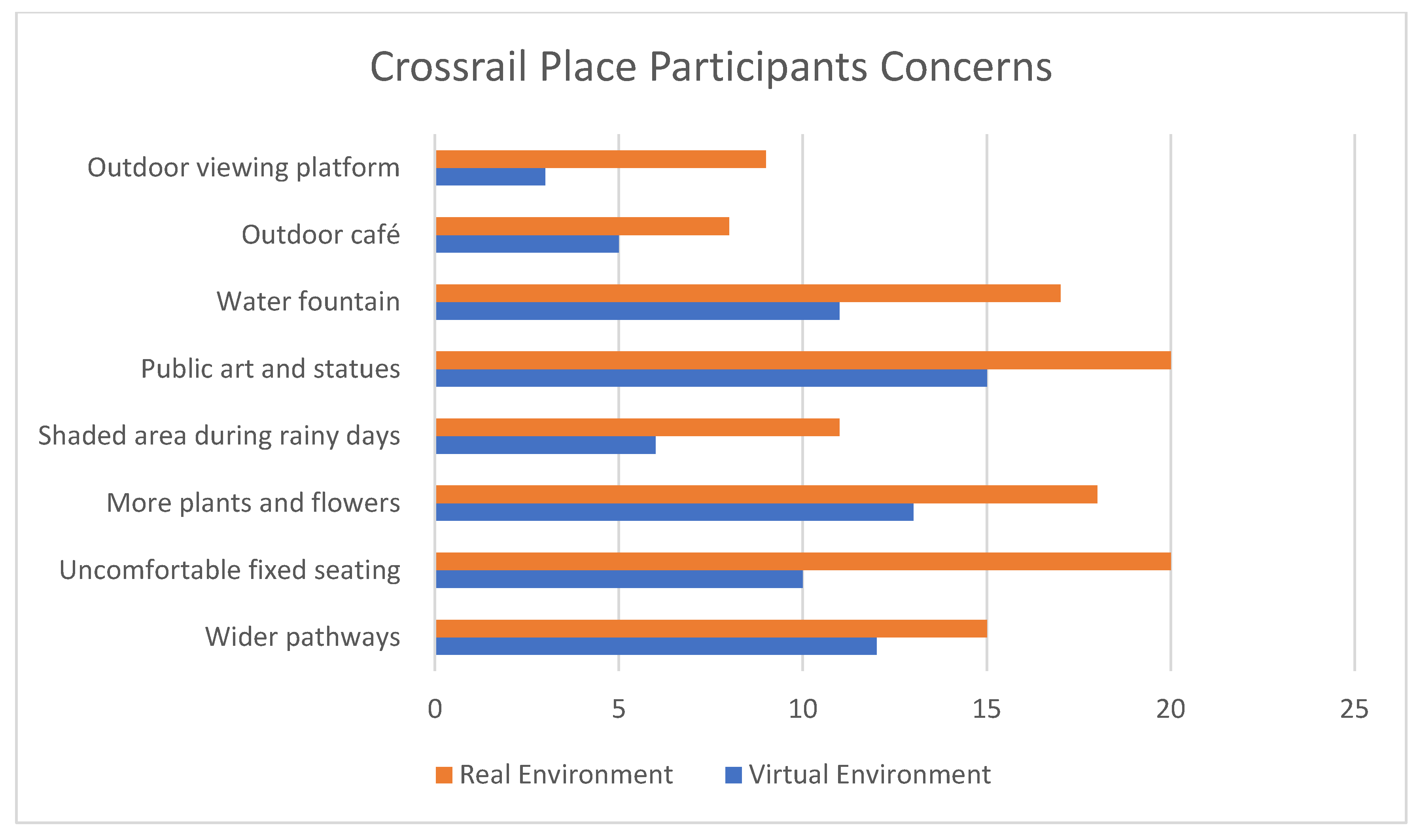
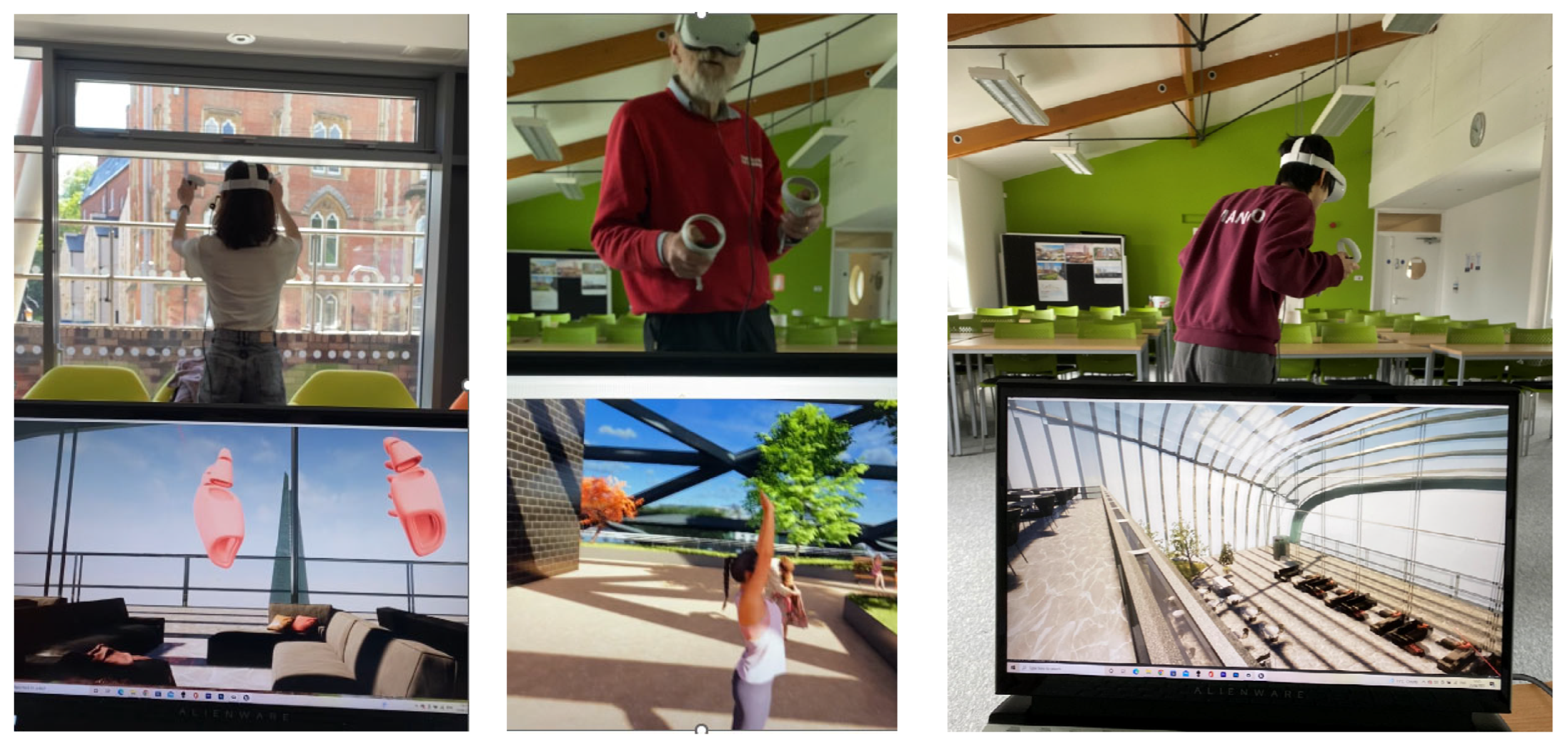
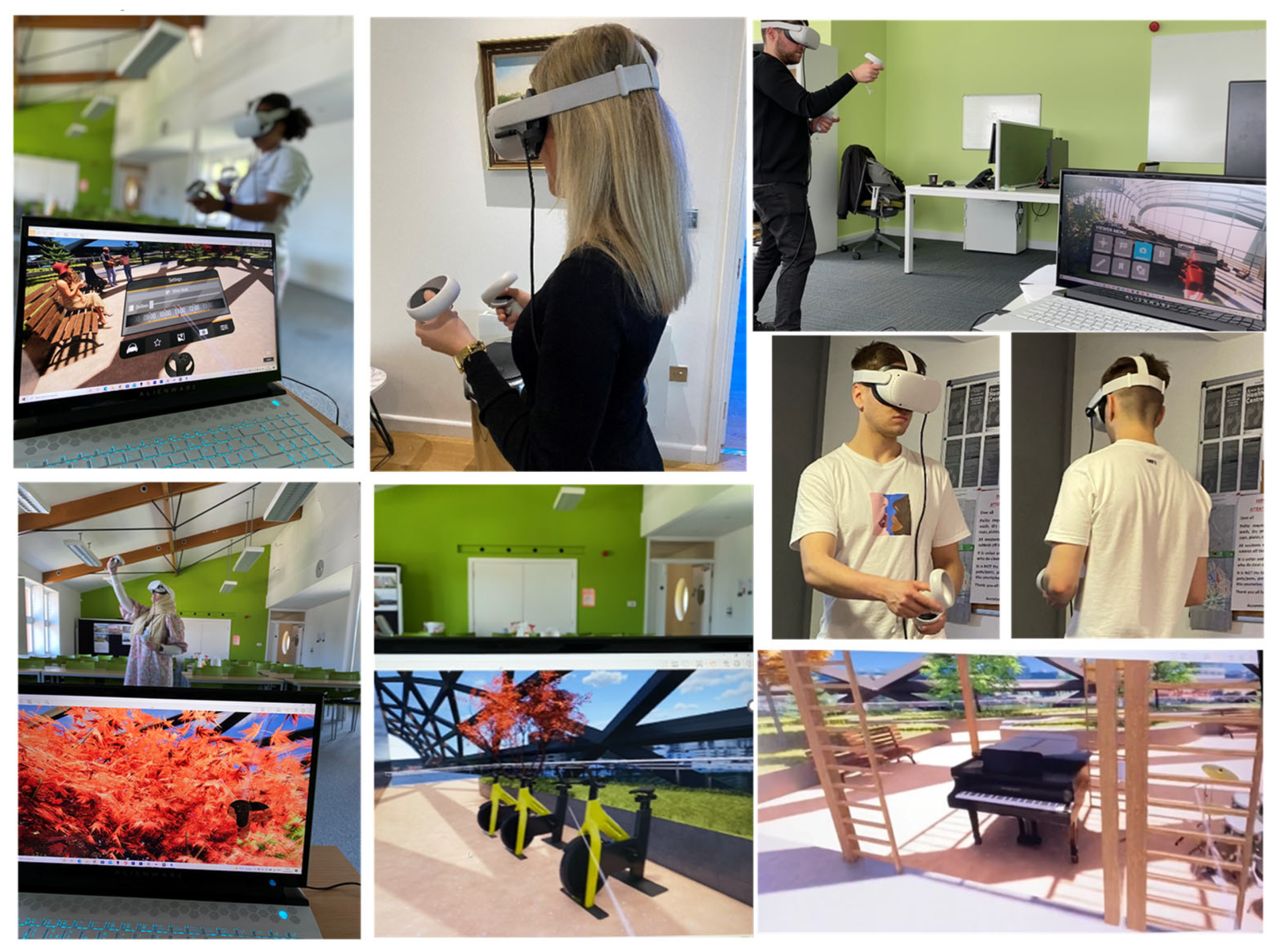
| Demographic Information | Sky Garden | Crossrail Place |
|---|---|---|
| Interviews number | 33 | 33 |
| Gender | ||
| Male | 39.3% (n = 13) | 45.4% (n = 15) |
| Female | 60.6% (n = 20) | 54.5% (n = 18) |
| Average age (years) | 28.2 | 30.3 |
| Residency/Work | ||
| Living/Working in London | 36.6% (n = 12) | 60.6% (n = 20) |
| Living Elsewhere in the UK | 39.4% (n = 13) | 24.2% (n = 8) |
| International Tourists | 24.2% (n = 8) | 15.1% (n = 5) |
| Activity | Duration |
|---|---|
| Induction (health and safety and consent) | 15 min |
| Survey | 10 min |
| Sickness Questionnaire | 5 min |
| London Sky Garden (VR experiment) | 10 min |
| Break (sickness questionnaire) | 10 min |
| Crossrail Place Roof Garden (VR experiment) | 10 min |
| Break (sickness questionnaire) | 10 min |
| Semi-Structured Interview | 30 min |
| Group | Description | Percentage | Number of Participants |
|---|---|---|---|
| A | Visited gardens before VR experiment | 36% | 12 |
| Exposed to the gardens only through VR | 64% | 21 | |
| B | Public users | 55% | 18 |
| Experts | 45% | 15 | |
| C | First-time VR users | 52% | 17 |
| Occasional VR users | 42% | 14 | |
| Regular VR users | 6% | 2 |
| Design Concerns | Participants: Previously Interviewed at the Sky Garden in London | Participants: Not Been to the Sky Garden (Interviewed during the VR Experiment) |
|---|---|---|
| Public seating | “It will be nice to provide more seating spaces for everyone and not only for people who are ordering food and drinks”. | “I think having more public seating spaces like benches or stair seating near the plants could make people feel more comfortable sitting without feeling forced to order food or drinks”. |
| Seating areas organization | “Despite the thing we are having right now because of COVID-19, I need more private seating areas. The seating spaces are comfortable but very close to each other. They need to be well designed and placed to maintain social distancing and privacy”. | “I also think it will be awkward having to share the sofa with strangers. If I am physically in the space, I will choose to sit on one of the chairs near the plants”. |
| Plants and green spaces | “I think with the name itself Sky Garden, I would like to see a different kinds of flowers and roses. If they can add more green features, it will differently encourage more people to come and visit, not only for the view”. | “With the name ‘garden’, you are expecting to see more natural plants. It would be nice to add more green space and a bit more flowers”. |
| Outdoor terrace | “The terrace was restricted with a certain number of people, so the garden might need a more open space for people”. | “I think maybe an open space, so instead of being in an indoor environment all the time, it may be a bigger outdoor area”. |
| Restaurant design | “I think that the restaurant in the middle is like blocking out most of the view; you have to go around it to see most of the city views and landmarks”. | “I don’t like the design and the position of the restaurant in the middle of the space I think it needs to be more open and the higher you go up the better view you would get; and for the restaurant design it would be better if it’s all glass and transparent so even people inside could enjoy the view”. |
| Accessibility | “I don’t know how it would work if you were handicapped in any way, or if you have a disability. A lot of the garden experience is on the stairs so you wouldn’t be able to see any of that if you are taking the elevator”. | “I always care about people with wheelchairs or old people. I didn’t see any ramps in the roof gardens. You could do a hybrid: blend ramps and stairs together, and it will be both statically and functionally so good”. |
Disclaimer/Publisher’s Note: The statements, opinions and data contained in all publications are solely those of the individual author(s) and contributor(s) and not of MDPI and/or the editor(s). MDPI and/or the editor(s) disclaim responsibility for any injury to people or property resulting from any ideas, methods, instructions or products referred to in the content. |
© 2023 by the authors. Licensee MDPI, Basel, Switzerland. This article is an open access article distributed under the terms and conditions of the Creative Commons Attribution (CC BY) license (https://creativecommons.org/licenses/by/4.0/).
Share and Cite
Ehab, A.; Heath, T. Exploring Immersive Co-Design: Comparing Human Interaction in Real and Virtual Elevated Urban Spaces in London. Sustainability 2023, 15, 9184. https://doi.org/10.3390/su15129184
Ehab A, Heath T. Exploring Immersive Co-Design: Comparing Human Interaction in Real and Virtual Elevated Urban Spaces in London. Sustainability. 2023; 15(12):9184. https://doi.org/10.3390/su15129184
Chicago/Turabian StyleEhab, Ahmed, and Tim Heath. 2023. "Exploring Immersive Co-Design: Comparing Human Interaction in Real and Virtual Elevated Urban Spaces in London" Sustainability 15, no. 12: 9184. https://doi.org/10.3390/su15129184
APA StyleEhab, A., & Heath, T. (2023). Exploring Immersive Co-Design: Comparing Human Interaction in Real and Virtual Elevated Urban Spaces in London. Sustainability, 15(12), 9184. https://doi.org/10.3390/su15129184







